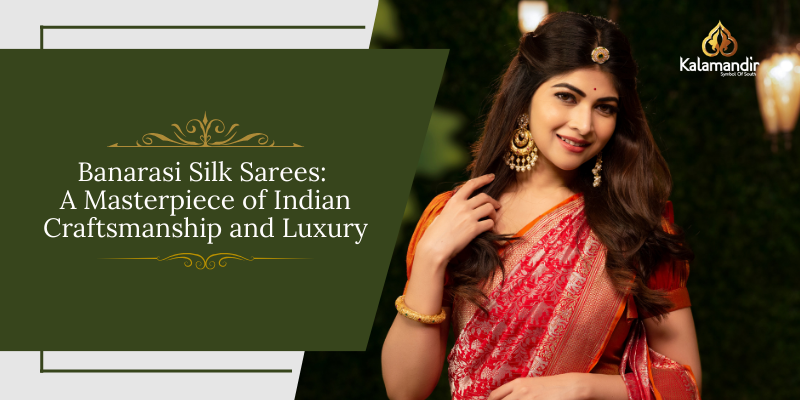Banarasi Silk Sarees are among the most sought-after and luxurious textiles in India, celebrated for their exquisite detailing, fine silk, and enduring sophistication. Crafted with passion and patience, these sarees embody tradition, culture, and artistry, originating from the ancient city of Varanasi, formerly known as Banaras. They encapsulate the rich artistic heritage passed down through generations.
The creation of Banarasi sarees is a slow and meticulous process that requires the expertise of weavers and a deep understanding of textile art. Each saree reflects dedication, taking days or even months to complete, with some of the most intricate designs woven over several years. Banarasi Silk Sarees hold a special place in Indian culture, particularly during weddings and festive occasions. Their significance goes beyond mere attire, symbolizing tradition, family, and reverence for craftsmanship.
The History of Banarasi Silk Sarees
The history of Banarasi Silk Sarees traces back to the Mughal era when Persian motifs were introduced to Indian weaving. This fusion of Persian designs with traditional Indian patterns laid the foundation for the iconic Banarasi saree. Banaras, situated on the banks of the Ganges, emerged as a center for silk weaving, where the finest materials and most intricate patterns came together in perfect harmony.
Weaving in Banaras is an ancient tradition deeply woven into the city’s religious and cultural life. While the art of weaving has existed for centuries, the Mughal influence elevated the sophistication of the craft by introducing complex designs, gold and silver brocade (Zari), and intricate embroidery. The weavers of Banaras embraced these changes, creating sarees that were admired not only for their beauty but also for their regal appeal.
Banarasi sarees soon became a part of royal wardrobes, symbolizing luxury and aristocracy. They were often presented as gifts to royalty or dignitaries, and the art of Banarasi weaving gained fame far beyond India’s borders. As the sarees continued to evolve, they became an emblem of pride and cultural identity, particularly in North India.
The Cultural Significance of Banarasi Silk
In Indian culture, Banarasi silk sarees hold immense significance, especially in weddings. A traditional Indian bride, adorned in a red Banarasi saree, symbolizes prosperity, beauty, and timeless grace. The dense, intricate patterns of gold and silver threads woven into the fabric represent blessings and wealth, making the saree a cherished part of a bride’s trousseau. Many families pass these sarees down as heirlooms, further strengthening their cultural and familial value.
Banarasi silk sarees come in several distinct varieties, each one as unique as the traditions that inspired them:
- Pure Silk: The epitome of luxury, pure silk Banarasi sarees are crafted from mulberry silk and are prized for their rich texture and luster.
- Organza: Delicate and lightweight, organza sarees offer a crisp, sheer texture perfect for formal gatherings.
- Georgette: Soft and fluid, georgette Banarasi sarees are known for their light drape, making them a popular choice for both casual and grand occasions.
- Shattir: Combining the durability of cotton and the sheen of silk, Shattir sarees strike a perfect balance between comfort and luxury.
- Tussar: With a slightly textured finish and natural appeal, Tussar silk sarees exude an earthy charm.
- Cutwork: Featuring intricate designs created by cutting away parts of the fabric, cutwork Banarasi sarees are often enhanced with delicate embroidery or zari, showcasing true artistry.
Banarasi silk sarees are renowned for their distinctive features, each one contributing to the saree’s royal appeal:
- Zari Work: One of the most iconic elements of a Banarasi saree is its intricate zari work. Gold and silver threads are woven into the fabric, creating breathtaking patterns that shimmer with every movement.
- Traditional Motifs: Floral vines, paisleys, and mythological figures adorn these sarees, each motif steeped in history and tradition.
- Pallu and Borders: Banarasi sarees are characterized by their richly decorated pallus and wide, ornate borders. The combination of these features creates an opulent, balanced look that is unmistakable.
- Rich Color Palette: Jewel tones like deep reds, emerald greens, and royal blues are the hallmarks of Banarasi sarees, adding to their majestic charm.
A Banarasi silk saree is a prized possession, and proper care ensures its beauty lasts generations. Always opt for dry cleaning and store it in a cotton bag to protect the delicate fabric. Keep it away from direct sunlight and moisture, as these can dull the sheen and cause damage over time.
Banarasi silk sarees are more than just attire. They are a celebration of India’s rich cultural heritage. Every Banarasi saree tells the story of centuries-old weaving techniques passed down through generations of artisans. Whether you are seeking something to wear for a special occasion or to pass down as a family heirloom, Kalamandir’s collection of Banarasi silk sarees offers a perfect blend of tradition, beauty, and luxury. Draping yourself in a Banarasi silk saree is not just about fashion but it is also about embracing the elegance and heritage that make Indian craftsmanship truly extraordinary.

